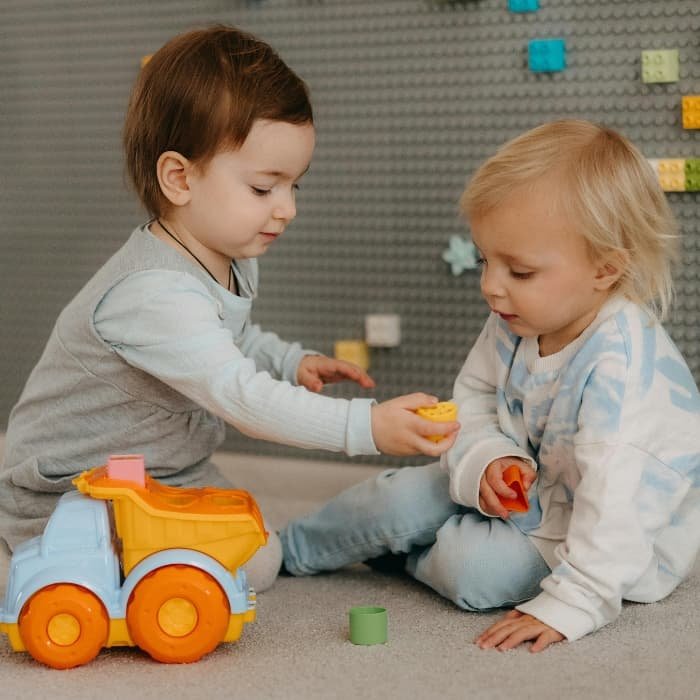One sunny day at the playground, a little one of mine held his bright toy truck tightly and watched other kids playing. When a friend asked to play with it, Jake looked upset, which shows the challenges parents face when teaching kids to share. Every parent needs to teach their child about sharing for their development. Sharing also helps them learn to care for others, work together, and make friends. Children may not understand what sharing means, and they may not be willing to give up their favorite toys. They may end up reacting with anger when asked to share. Let’s get into the blog to learn different ways of teaching four-year-olds to share with patience and the right strategies.
Why is Sharing Essential for a Four-Year-Old?
Sharing is an essential skill for a child’s social interactions. It helps them navigate relationships and foster a sense of community with their peers.
Develop Empathy and Social Skills
Sharing also teaches children to understand what others are feeling. This helps them mature in their empathy for others, which is the capacity to feel and identify with what others are feeling. Practicing sharing also helps them develop socially, which is essential for interacting with other children.
Helps with Cooperation and Making Friends
Sharing teaches kids the importance of working together. When they share toys or games, they learn to take turns and communicate, which builds cooperation. This not only helps them make friends but also strengthens their friendships.
Prepares them for School and Group Settings
Sharing is an essential skill for school and other group environments. As children learn to share at home, they become more comfortable in classrooms and activities where teamwork is needed. This preparation helps them adapt to new social situations and thrive in group settings.
Why do Kids find Sharing Challenging?
It’s essential to acknowledge the reasons why young children often struggle with sharing. Understanding these challenges can help parents to guide their kids more effectively.

Developmental Stage
At around four years old, children reach a developmental stage where they view the world primarily from their perspective. This makes it difficult for them to understand that others have feelings and needs as well, leading to struggles with sharing.
Possessiveness over Toys and Belongings
Children often feel a strong attachment to their toys and belongings. This possessiveness can make them reluctant to share as they may not grasp the joy of giving or the benefits of shared play.
Fear of losing control over their Items
Many kids fear that if they share their toys, they will lose them or not get them back. This fear of losing control can lead to resistance when asked to share making it a challenging concept for them to embrace.
Practical Strategies to Teach Sharing
Teaching children to share can be a rewarding journey. Here are some practical strategies to help your child learn this critical skill.
Model Sharing Behavior
Demonstrate sharing in everyday life such as sharing food or taking turns. Use phrases like, “I’m sharing my snack with you. Would you like to share yours?” This shows them what sharing looks like in action.
Use Play Based Learning
Use learning through play such as board games or building blocks to help make sharing enjoyable. Role-playing with stuffed animals or dolls can give kids another perspective on sharing in a safe and imaginary setting.
Praise and Positive Reinforcement
Acknowledge your child when they are freely communicating. Praise will encourage your child to repeat good behavior: “I love the way how you share that toy with your friend.” This is a form of positive reinforcement that encourages them to post more.
Set Clear Expectations
Before playdates or group activities, clearly explain the sharing rules. Let your child know what is expected of them. Using timers for turn-taking can also help. This makes sharing feel fair and organized which can reduce any worries they might have.
Teach Problem-Solving Phrases
Always encourage your child to express their needs by saying phrases like, “Can I have a turn when you are done?” or “Let’s play with this toy together.” This helps them communicate and negotiate sharing.
Avoid Forcing Sharing
Allow your child to keep special toys aside if they are not ready to share them. Encourage the sharing of other items and help them understand natural consequences, such as how friends may not share back if they don’t share first.
Mistakes to Avoid for Teaching Four-Year-Olds to Share
Punishing Instead of Guiding
Teach your child to share rather than punishing them for not sharing. Don’t tell them not to do it, but to also use these as learning opportunities. Discuss the importance of sharing and how they cannot share their feelings too openly.
Comparing them to other Kids
All kids learn at their own pace, so avoid making them feel bad with comparisons. Instead of, “Look at how nicely your friend shares.” This will help focus on their original strengths and how far they have come. Praise them for their little successes and build their confidence.
Expecting immediate Perfection
Keep in mind that learning to share is a process, and mistakes are part of it. Children often struggle with sharing — and it’s perfectly normal. Encourage your child to practice sharing and let them know that, over time, it will become easier.
Conclusion
Teaching your child to share is a process that involves some patience, understanding, and ongoing instruction. Although it can be difficult at times, experiences like this are crucial for their social growth. With sufficient practice, they won’t just be better at sharing; they’ll also enjoy these interactions with their peers.


